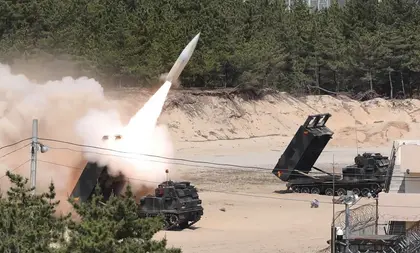The US media site ABC News quotes a US official saying, in relation to ATACMS, that “They are coming,” while at the same time hedging his bets by noting that, as always, such plans are subject to change until officially announced.
A second official said the missiles are “on the table” to be included in the next US military security assistance package for Ukraine, although a final decision has not been made.
If they do come, ATACMS will potentially play a significant role in destroying Russian materiel and personnel and important command centers as well as in interdicting enemy logistics.
Designed to destroy targets at ranges up to 300 km, these missiles could effectively target Russian military facilities in occupied Crimea and the high-profile Kerch Bridge. That is assuming the US would not place restrictions on their use against legitimate targets located on Ukrainian territory.
It is possible that, as with F-16 fighter aircraft, the US might impose restrictions on the use of ATACMS against enemy forces located on Russian territory.
Significant HIMARS/GMLRS strike by Ukrainian forces.#Ukraine pic.twitter.com/6pJOdvyaaD
— (((Tendar))) (@Tendar) March 31, 2023
What is ATACMS?
ATACMS (pronounced “attack’ems”) is a tactical ballistic missile manufactured by the US defense company Lockheed Martin. Development of the missile started in 1980, based on a US requirement for a long-range, non-nuclear capability to strike enemy rear-area logistic and reserve positions.
It has a solid propellant motor which gives it a range of up to 300 km. The missile is 4 meters high and 610 millimeters in diameter.

Ukraine Beyond Trump
It can be fired from the tracked M270 Multiple Launch Rocket System (MLRS), and the M142 High Mobility Artillery Rocket System (HIMARS), both of which are in use with the Armed Forces of Ukrainian (AFU).
To date there have been five variants of the missile produced:
- M39 cluster munition – inertially guided, carrying 950 M74 anti-personnel and anti‑materiel sub-munitions with a range of 25-165 km. Production ceased in 1997; total produced: 1,650;
- M39A1 – GPS-aided guidance added, size of motor increased resulting in reduced payload of 300 M74 APAM sub-munitions but maximum range increased to 300 km. Production ceased in 2003; total produced: 610;
- M48 – GPS-aided guidance fit with 230-kilogram WAU-23/B penetrating high-explosive blast fragmentation warhead (same as US Navy Harpoon anti-ship missile), maximum range 300 km. Production 2001-2004; total produced: 176;
- M57 – improved version of M48 with greater accuracy: Circular Error Probability (CEP) of 9 meters. Production 2004-2013, total produced 513;
- The M57E1 – upgraded M39 and M39A1 with improved motor, updated navigation and guidance software and hardware giving a CEP of 3 meters. It is fitted with the WAU-23/B warhead section instead of the M74 APAM sub-munitions with aproximity sensor for airburst detonation. Production commenced in2017 with total assessed quantity produced 1,200.
Once delivered to Ukraine, the missiles will quadruple the 70 range of the current M142 HIMARS and M270 MLRS platforms, which have already become game changers.
Using the current weapons, the AFU have destroyed a number of enemy ammunition dumps and command centers along with hundreds of armored vehicles, artillery, antiaircraft systems and radar stations and their crews.
Ukrainian HIMARS strike targeting a Russian ammunition dump in Kherson Oblast. pic.twitter.com/8Nr4IUR2EB
— OSINTtechnical (@Osinttechnical) August 13, 2023
ATACMS, will give Ukrainian forces the ability to destroy such targets far deeper into the enemy's rear.
In 2022, the average price of one ATACMS missile was approximately $1.5 million.
History
The XMGM-140A missile was first test-launched in 1986. In 1991, the modified MGM-140 was officially commissioned for use by the US Army with shortly afterwards, 32 of the missiles being used during Desert Storm against Iraqi facilities. Their effectiveness was assessed as very high.
A series of upgrades that followed, one of which being GPS guidance added to the inertial targeting system, significantly increased the speed, range and precision of the ATACMS. In 2003, Operation Iraqi Freedom saw the launch of more than 450 ATACMS missiles.
The Iraqi army's outdated air defenses were simply unable to defend its important facilities, communications hubs and command centers against the American missiles that flew at a formidable speed of 5,000 kmph.
Work began on an ATACMS replacement in 2016, which became the Precision Strike Missile (PrSM) program in 2019, with a planned in-service date of 2023. PrSM, as currently envisaged will be fired from the same M270 MLRS and M142 HIMARS launchers with a range in excess of 500 kilometers.
Ukrainian HIMARS strike on Russian R-330Zh Zhitel EW system hidden under the trees. pic.twitter.com/uoh3KLBxUs
— Clash Report (@clashreport) August 29, 2023
Why does Ukraine need ATACMS?
While many Russian military bases, logistics facilities and other targets in Crimea are out of reach of Ukraine's HIMARS rockets, ATACMS would effectively overcome this shortcoming. In particular, they could neutralize the Russian ballistic missile complexes that frequently bombard Odesa.
ATACMS is high-speed ballistic missile that climbs as high as 50,000 m, changes trajectory in flight and accelerates up to Mach 3 making it extremely difficult to intercept.
The short-term provision of even a small number of ATACMS could radically change the situation, because they can interdict Russia's key supply routes that run very far from the frontlines
By destroying bridges and railroad facilities they would significantly debilitate the Russian forces. The loss of missile and radar complexes in the occupied territories, would mean they could no longer terrorize Ukrainian cities.
You can also highlight the text and press Ctrl + Enter









